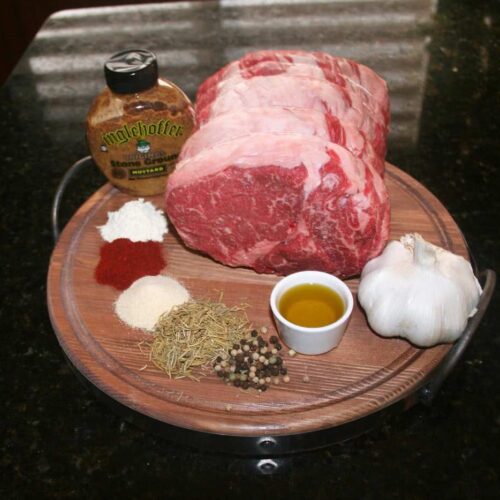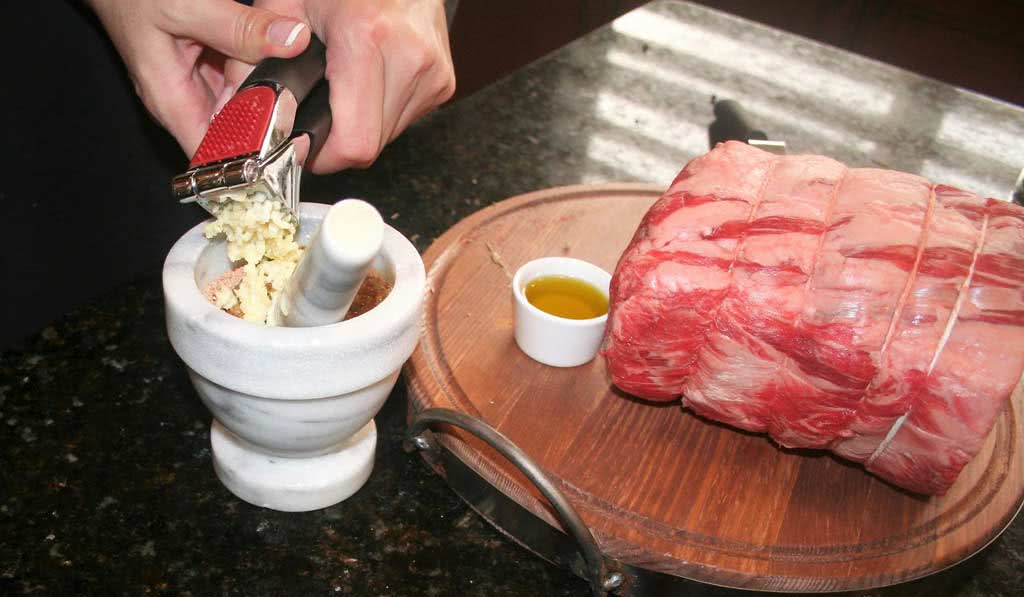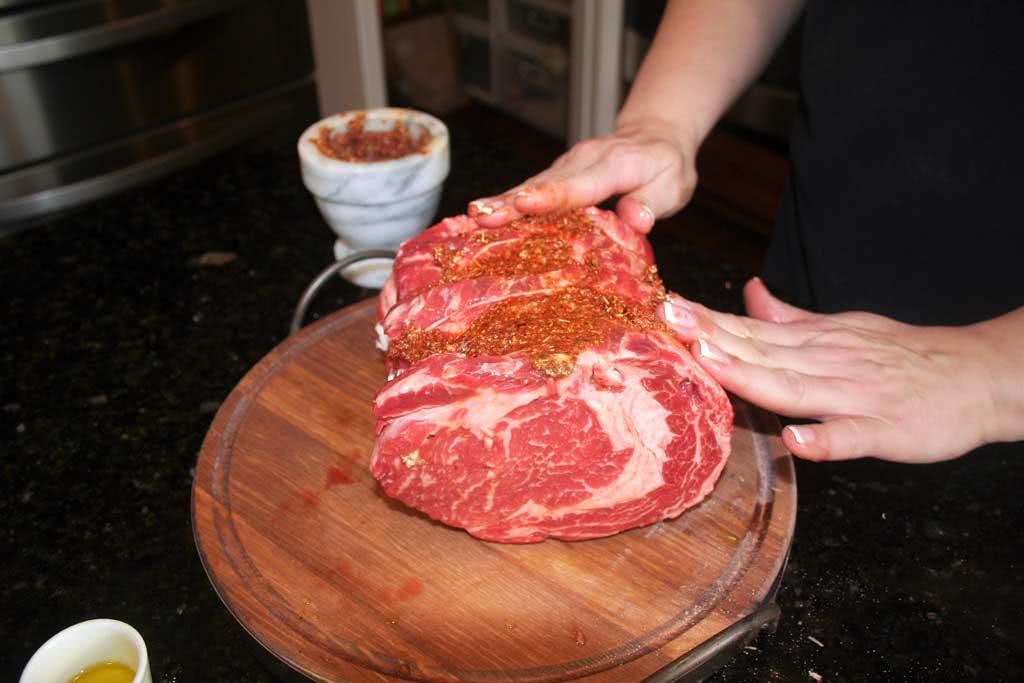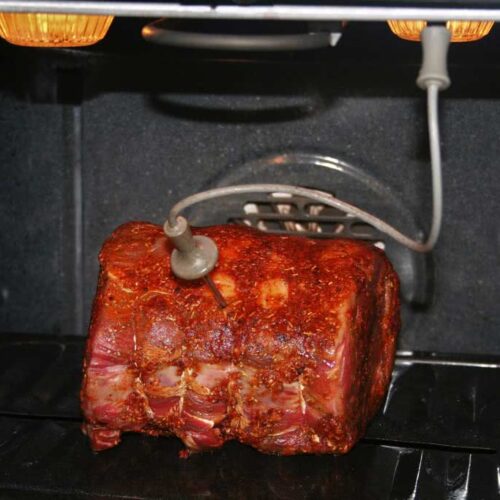Low Sodium Prime Rib Roast And Beef Au Jus
How do you celebrate the holidays? In our house it is Christmas that we celebrate. Christmas morning is spent with just us and the kids for breakfast. Traditionally then, we are off to spend time with extended family later that day. The big meal we eat at home to celebrate is on Christmas Eve. Ever since I was little, it has been with a Beef Roast. Yes, just like the Who’s in Whoville we had our Roast Beast! The problem now was to hack the salt, keep the taste, and allow us a great tasting low sodium Prime Rib Roast and Beef Au Jus.
New Healthy Traditions
Roast & Yorkshire Pudding (what the British call popovers) have been a traditional Christmas pairing since the Victorian Age. Christmas dinner itself is as diverse as the ways people celebrate the holidays. Most meals have food that is influenced by family traditions and regions.
Most are centered around an entree of roasted meat. Some of the earliest recorded Christmas feasts included what was hunted, like wild boar and elk with dove and pheasant. In the more civilized Victorian era, it became roast beef with turkey and goose. The Irish had mutton and ham. Dishes from Italy, Spain, and Greece included fish dishes. When the first settlers reached New England, local seafood like lobster and oysters were included.
In America, Turkey became the primary meal of Thanksgiving, which is celebrated in the month of November. Roast Beef and Ham became the predominant Christmas Entree. As ham is way too high in sodium, and we have my low sodium Apricot Mustard Glazed Turkey on Thanksgiving, Christmas is Prime Rib.
Low Sodium Swaps To Make
A roast is fairly simple. it is all about building a good spice crust and then cooking it low and slow until the center is up to proper temperature. Traditionally the rub includes salt, and we are looking to build our crust without salt. We are replacing the salt in our spice rub with rosemary, paprika, and a salt free stone ground mustard.
The other place salt reside is in the beef au jus. An au jus is basically a thin gravy made from stock, boiled vegetables, and the prime rib drippings from roasting our prime rib. We want to make sure we use an Unsalted Beef Stock or broth or the lowest sodium you can find.
Use The Right Tools
If you have never trimmed and tied a roast, a butcher can help you with this. If you do a lot of cooking and grilling, butcher’s twine is a good tool to have in your kitchen. Not just for tying a roast, or legs of chickens or turkeys, you can use it to tie a cheesecloth wrapped bundle of spices for soups or stocks.
The other must have tool here is an accurate meat thermometer. Some ovens have them built in, or there are many available you can leave in and read remotely with a receiver or phone app. If in need, and standard manual one will do just as well.
The Recipe For Low Sodium Prime Rib Roast
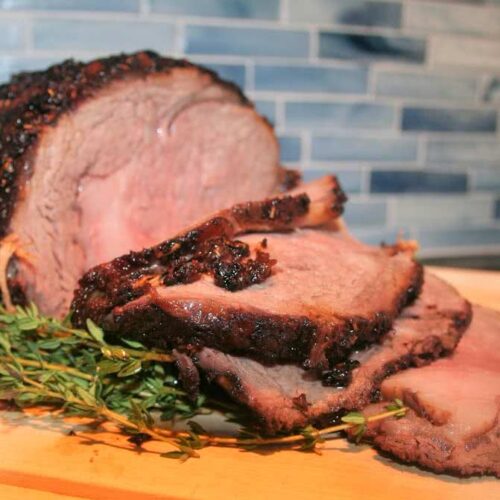
Low Sodium Prime Rib Roast And Beef Au Jus
Ingredients
For The Prime Rib
- 4 lbs Bone-in Prime Rib Roast (ask your butcher to trim & tie it to make it easier to roast)
- 4 tbsp Olive Oil (enough to coat both sides of the roast)
- 2 tbsp Fresh Ground Black Pepper
- 2 tbsp Garlic Powder
- 2 tbsp Onion Powder
- 2 tbsp Fresh Rosemary chopped
- 1 tsp Sweet Paprika
- 1 tbsp Stone Ground Mustard lowest sodium possible
- 2 cloves Garlic minced
Instructions
To Make The Prime Rib Roast
- 2 hours prior to cooking - In a small bowl (or in a mortar and pestle) add the black pepper, garlic powder, onion powder, Rosemary, Paprika, Mustard, and minced garlic and mix thoroughly to create the rub that will create that lovely crust on the outside of the meat). Rub the roast thoroughly with Olive Oil to coat the roast which will allow the rub to stick to it. Next, generously coat the roast with the spice rub and coat completely. Place the roast on a plate in your refrigerator until 30 minutes before cooking.
- 30 minutes before cooking - Take the roast out of the fridge and allow it to come to room temperature (30 minutes). Also, preheat your oven to 450 degrees F and allow to heat while the roast is coming up to room temperature.
- Place the roast on a rack in a roasting pan, the fat side should be facing up and bone side down.
- Cook your roast for 15 minutes, then reduce the oven temperature to 325 degrees F. Continue to cook your roast until your meat thermometer reads 125 degrees F. Check the temperature at the thickest part of the roast. Make sure the thermometer is not touching the bone to get a true reading. Estimate about 15 minutes of cooking time per pound of prime rib.
- Once the thermometer hits its target temperature, remove the roast from the oven, cover it in foil, and let it rest for 20 minutes. At this time, use the pan drippings to create your au jus (instructions below). The roast will continue to cook as the juices inside settle, raising the internal temperature to 135 degrees F, and then it will come back down to 125 in that 20 minutes. Untie the roast and slice and serve for a perfect prime rib.
Notes
Nutrition
The Recipe For Low Sodium Beef Au Jus

Low Sodium Beef Au Jus
Ingredients
- Roasting Pan from Prime Rib with meat drippings
- 3 cups Unsalted Beef Stock Swanson's unsalted is lower than the "low sodium versions"
- 1 medium Onion chopped
- 2 medium Carrots chopped
- 2 standard Celery Stalks chopped with leaves
- 1/4 tsp Fresh Ground Black Pepper to taste
Instructions
- Place the roasting pan on the stove-top, across two burners, and add the chopped carrots, celery, and onion. Cook on high for a minute, stirring everything around with a wooden spoon, until the veggies are a bit browned and most of the liquid has cooked off — but don't let anything burn.
- Now pour in about half of the stock and cook for another minute over high heat, while scraping all those toasty bits (called fond) away from the bottom of the pan with your wooden spoon.
- Now pour the contents of the roasting pan into a large saucepan along with the remaining stock. Simmer for about 20 minutes or until the liquid has reduced by about one-third.
- Strain out all of the remaining chunks through a fine mesh sieve or even a sieve with a coffee filter as a liner to just keep as much liquid as possible. Even squeezing or pressing out the remaining juices from the roasted veggie bits. Serve hot about 2 oz per person, either poured over the roast or in a small bowl to allow each person to use as desired.

